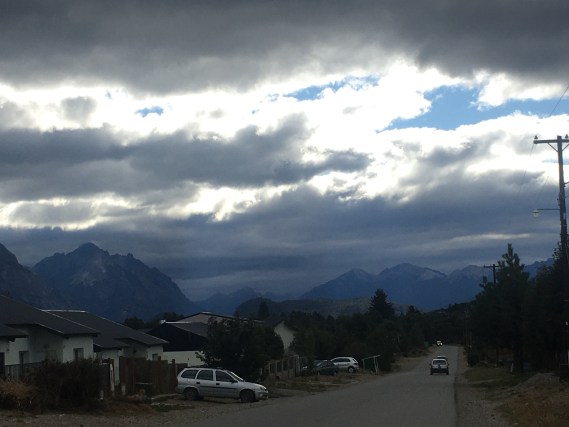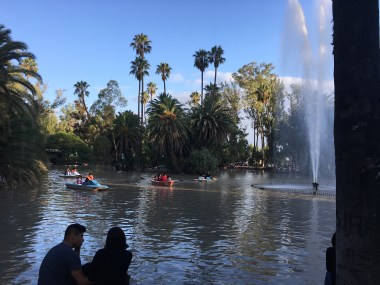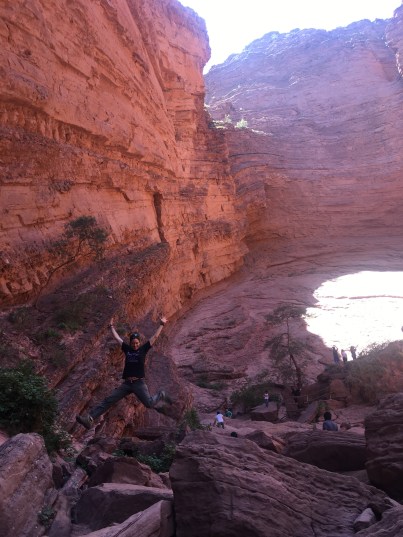Don’t Cry For Me, Argentina!
I hope to be back soon, but in the meantime, I wanted to share some of the Argentina-esque experiences that I found to be unique compared to other countries I’ve visited.1
First, Argentina is huge. It’s nearly as long (north-to-south) as the US is wide (east-to-west).

As such, it has an incredible diversity of landscapes – a variety of deserts, salt flats, forests, lakes, mountains, coast, and more that I have yet to discover.
Quiz: Where can you find the tallest mountain in the Americas? You guessed it; it's in Argentina! Nope, it's NOT in the Patagonia. It's called Aconcagua, and rises to 22,841 ft (6,962 meters), located in the province of Mendoza near the Chilean border.
Being in the southern hemisphere, the seasons are opposite to those in the US – and most places throughout the country experience all four seasons pronounced, (unlike many of the other South American countries I’ve visited that are located closer to the equator and often experience two seasons – rainy and dry season). In some places in the north it can reach more than 120°F heat index in the summer. Meanwhile, the southern-most part of the country has 19 hours of sunlight during peak summer (December 21), and only about five hours of daylight in peak winter, similar to Alaska.
 I had the pleasure of spending a month traveling through the northern half of the country, following the western border with Chile, along “La Ruta 40”. (My travel path is drawn in purple on the map.)
I had the pleasure of spending a month traveling through the northern half of the country, following the western border with Chile, along “La Ruta 40”. (My travel path is drawn in purple on the map.)
When I first entered Argentina in the north, I stayed a few days in the city of San Salvador de Jujuy. My first impression was that it reminded me more of a small city in the US than of a comparable-sized city in the other South American countries I have visited.
I tried to figure out why, and I decided it was mainly because of the number of people driving around in personal vehicles. Also, there was a network of wide roads and bridges with clean sidewalks and well-maintained buildings. And the water from the tap was potable!
When I was told that this province was one of the poorer provinces of Argentina, I realized there was more wealth in Argentina than in other countries I had visited in South America. (Argentina does in fact have the second highest GNI per capita in South America, (after Chile) – twice that of Colombia, which has the next highest.)2

Having been a rural water systems engineer in Peru, trying to improve drinking water quality there, I was really happy to find that I could drink from the tap in all the places I visited throughout my time in Argentina, not just in Jujuy. (Though I was told that it might be questionable to drink from the tap in some of the smaller, more remote towns in the country.)
Quiz 2: Where was the biggest dinosaur in the world found? Yep, also Argentina! Argentinosaurus is the biggest dinosaur skeleton found in the world so far, and Giganotosaurus is the biggest carnivore discovered so far - both found in the Patagonia of Argentina.
Bear with me, while I geek out a little bit more.
I love walkable cities, and many of the cities I visited in Argentina were, well, somewhat walkable. That is to say that in most neighborhoods you could always find a store with the necessities within walking distance if you don’t mind walking a bit.
The cities tended to sprawl, (probably due to the extensive space available,) so they were designed to accommodate vehicle traffic necessary to carry you those longer distances across the city, which often takes away from the walkability of a place. (On the other hand, all the small towns were very walkable – possibly one of the reasons I love small towns so much.)
 Most cities had good (but not exceptional) public transportation. What was exceptional was the universal fare card for public transportation that works in multiple cities throughout the country!3
Most cities had good (but not exceptional) public transportation. What was exceptional was the universal fare card for public transportation that works in multiple cities throughout the country!3
The only down side is that you are obligated to use the fare card to pay the bus fare and you aren’t allowed to pay cash on the bus (like many other countries). Since I didn’t have a card, I had to find someone who would pay my fare and I would pay them cash. More correctly, I would TRY to pay them my fare in cash, but 99% of the people who paid my fare with their card refused to let me pay them back, looking at me like I was crazy and saying, “Por favoooor!”
If you have read my previous blogs, you are familiar with the surprising levels of generosity I came across during my travels in Argentina, and this is just one example. It was very rare that someone would let me pay them back for them something they offered me or helped me with, and I was often met with a “Por favor!” (“Please! You will NOT be paying me back for that!”), as if they were offended that I didn’t realize it was a gift, and I was insulting them for even thinking that I should offer them something monetary in return.
Even thanking someone was often met with a “Por favor!”, bringing Argentina in competition with Colombia for the kindest response to “Thank you”. (The most common response to “Thank you” in Colombia was, “Con gusto!” or “with pleasure!”)
 Maybe you remember mate (“mah-tay”)? This is such a unique characteristic and defining feature of the country that I have to mention it here.
Maybe you remember mate (“mah-tay”)? This is such a unique characteristic and defining feature of the country that I have to mention it here.
Mate (“mah-tay”) is a ritual, a tradition, a social activity, a part of daily life, and/or an event. It’s like drinking coffee in the mornings (and/or throughout the day). It’s like having a smoke break. It’s like having a drink with friends or co-workers. It’s like offering a beer to a stranger or an acquaintance. It’s like inviting people over for brunch.
Mate is an herb from northeast Argentina (also grown in the bordering regions of Paraguy and southern Brazil) that is drunk as a loose-leaf tea in a special recipient (also called a “mate”), with a special metal straw called a “bombilla”. There is a universal procedure for preparing the mate and etiquette for drinking it – it’s serious business.
Everyone drinks mate,4 and most people drink it all throughout the day. If you are with someone else, you drink mate together, and if you want to be cordial with someone who passes by, you offer them a mate.
Another thing that stood out about Argentina is that everyone was white.4 Hyperbole again. But, the percentage of white people was astounding compared to what I had seen in other South American countries. It turns out that in addition to the Spaniard colonists, Argentina had a huge migration of Italians starting in about 1860 and lasting for around a century.
I’m not sure if it’s related, but Argentina has a unique way of speaking Castellano (Spanish)…so much so, that in Argentina I felt like I had regressed a couple years in my understanding of Spanish, and I often had to listen extra carefully and ask people to repeat things.
Every country has its own slang and unique terms, but in Argentina verbs are actually pronounced differently and the “y” and “ll” are pronounced like “jsh” instead of “y”… in addition to all the slang and Argentina-specific words.
Besides getting used to the accent, one of the first language differences I had to learn was the Argentina use of “Viste?”
“Viste?” doesn’t only mean “did you see?” like everywhere else I had been. In Argentina, it’s a way to say “you know?”, just like “Cacha’i?” in Chile.
For example, someone would be explaining to me, “I work 8 hours in the office, and then I work three more hours in the night at the restaurant down the street, “viste?”, and I replied “no, no lo he visto” (“No, I haven’t seen that restaurant.”), thinking they were asking if I’d seen the restaurant where they worked.
But they were really saying “You know what I mean?” So I should have nodded in understanding, saying, “Si,” (“Yeah, I get you; that’s a long day of work!”) Oops.
Thankfully, my first couchsurfing host realized my misunderstanding after he received a few unexpected responses, and he was nice enough to explain the Argentina “viste” to me.
My favorite Argentin-ism is probably “che”, which is how you can refer to someone to get their attention – a friend, a partner, or even someone you don’t know. The closest thing in English would be saying “hey”, (though to me, che seemed to be a little warmer than “hey” and a little closer to a universal nickname for everyone).
“Che, can you pass me the salt?” “What do you think about this, Che?” “Che, look at this!” “Let’s go to the city, Che.”5
Also, “Re” (pronounced “ray”) added to the beginning of a word doesn’t mean it’s been done again like in English; it adds emphasis, like saying “really”, “super”, or “extra”.
“Re interesante, che!” (“Really interesting, che!”)
This is not nearly a summary of Argentina, but simply a compilation of a few experiences that I found to be unique to Argentina in my short time backpacking through parts of the country, after having visited a few other countries in South America. I never made it to the capital, Buenos Aires, nor to much of the Patagonia (except Bariloche); I really only got a quick peek of the country.
Like most countries, each region has its own sub cultures, and the more time you spend in a place, the better you get to know it as you see past the superficial experiences of a few encounters with a few people. So I hope you enjoy my observations, but also take them with a grain of salt; and I hope to one day be able to explore more, and if so, I’ll share more with you here!
Famous Footnotes
- These are things that were unique to Argentina, based on my travels, having explored Peru, Colombia, Ecuador, and Bolivia. However, some things, (like mate,) aren’t restricted to the borders of Argentina and can also be found in some of the neighboring countries of Paraguy, Brazil, and even parts of Chile.
- Argentina’s GNI is 1/3 that of the US. GNI = Gross National Income. I looked at GNI per capita, converted by PPP (purchasing power parity) from 2018, as reported by the World Bank, which can be found here: https://data.worldbank.org/indicator/NY.GNP.MKTP.CD
- The “SUBE” is the universal bus/metro card https://www.argentina.gob.ar/sube/en-tu-ciudad
- Please allow my hyperbole.
- Though attributed to Argentina, some say that “che” actually originated much earlier in Europe. (Fun facts for the linguists among you). https://en.wikipedia.org/wiki/Che_(interjection), https://www.bbc.com/mundo/noticias/2013/02/130213_che_argentino_jr















 Katherine (the woman with the three kids) is a pediatrician and former Air Force. With her husband and kids, they had spent the last year traveling through the US in a camper van. They had recently decided to move to Bariloche to live for at least a few months here. Her husband traveled regularly back to the US for work, and in March he had gotten stranded there, unable to return to Argentina. Finally, she had had to make the decision to pack up everything and head back to the US since it was uncertain when he’d be able to come back to Argentina.
Katherine (the woman with the three kids) is a pediatrician and former Air Force. With her husband and kids, they had spent the last year traveling through the US in a camper van. They had recently decided to move to Bariloche to live for at least a few months here. Her husband traveled regularly back to the US for work, and in March he had gotten stranded there, unable to return to Argentina. Finally, she had had to make the decision to pack up everything and head back to the US since it was uncertain when he’d be able to come back to Argentina. The older woman who was traveling alone explained that she had regularly made the trip between the US and Argentina for decades because her husband is Argentine. This time she was heading back to the US without him. They had come to visit his father, but because of the quarantine, his father’s caretakers had gone back to be with family, so he staying to take care of him. Since her home and work (she volunteers at the Missouri Botanic gardens, which ironically does work in Oxapampa) were back in the States, she had decided to head back alone. She commented to us ironically that she had been a flight attendant on Eastern Airlines, the same airline (well same name anyway) that would take us all back to the US.
The older woman who was traveling alone explained that she had regularly made the trip between the US and Argentina for decades because her husband is Argentine. This time she was heading back to the US without him. They had come to visit his father, but because of the quarantine, his father’s caretakers had gone back to be with family, so he staying to take care of him. Since her home and work (she volunteers at the Missouri Botanic gardens, which ironically does work in Oxapampa) were back in the States, she had decided to head back alone. She commented to us ironically that she had been a flight attendant on Eastern Airlines, the same airline (well same name anyway) that would take us all back to the US.











 As you climb, every now and then you are rewarded with indescribable views of the lakes below.
As you climb, every now and then you are rewarded with indescribable views of the lakes below.






























 Oscar also introduced me to the card game “escoba” (“broom”), which uses a Spanish deck of cards similar to the traditional poker deck… but completely different. It does not include the 8, 9 and 10 cards, so the jack is worth 8 (though it is marked with a “10”), there’s a horse worth 9 (though it is marked with an “11”), and the king is worth 10 (though it is marked with a “12”). To score points, you then have to make hands that add up to 15, remembering that some cards aren’t actually worth their face value. In conclusion, it is really confusing and challenging (but fun).
Oscar also introduced me to the card game “escoba” (“broom”), which uses a Spanish deck of cards similar to the traditional poker deck… but completely different. It does not include the 8, 9 and 10 cards, so the jack is worth 8 (though it is marked with a “10”), there’s a horse worth 9 (though it is marked with an “11”), and the king is worth 10 (though it is marked with a “12”). To score points, you then have to make hands that add up to 15, remembering that some cards aren’t actually worth their face value. In conclusion, it is really confusing and challenging (but fun).










































